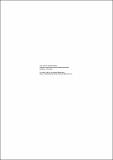| dc.contributor.author | Henry, Wesley R. | |
| dc.date.accessioned | 2011-11-10T15:35:21Z | |
| dc.date.available | 2011-11-10T15:35:21Z | |
| dc.date.issued | 1980-03 | |
| dc.identifier.citation | Henry, Wesley R. (1980) Management planning for tourism in Amboseli: incorporating behavioral information on park users. Working paper no. 365, Nairobi: Institute for Development Studies, University of Nairobi | en_GB |
| dc.identifier.uri | https://opendocs.ids.ac.uk/opendocs/handle/20.500.12413/1235 | |
| dc.description.abstract | A basic tenet for planners of Amboseli National Park is that many benefits result from environmental preservation. Maximizing theses benefits is the major function of management. The carrying capacity of the park for tourism is a useful approach to management in this situation since it is concerned with finding a balance between preservation and use.
An examination of existing research and planning efforts from a capacity perspective reveals a deficiency of behavioral information on park users. Research reported in this paper is a first attempt at overcoming this deficiency.
Highly specific expectations and preferences would greatly reduce potential capacity, but response indicated park visitors may have considerable flexibility in their expectations and preferences. Capacity can be increased beyond its present level because there are many elements in the experience contributing to visitor satisfaction which can be enhanced by better management.
This conclusion was supported by the fact that a lack of information, especially resulting from uniformed and uncommunicative rangers and drivers, was one of the problems bothering visitors most. Visitors supported using guides and were willing to pay for them. Furthermore, information may be useful in correcting many existing misconceptions and aid in reducing depreciative types of behavior.
At present, crowding and congestion are problems existing primarily in the vicinity of lions and cheetahs. Enhancing visitor satisfaction will require vehicle use around these animals to be limited to 4-8 vehicles at any one time. Vehicles must first be prohibited from approaching the predators too closely, and then an optimal number can be determined as a function of the behavior of visitors and drivers.
Site management and indirect regulations were the most favoured management techniques. Indirect regulation through use of interpretive guides and better trained drivers, not unexpectedly, were strong approved. More importantly, people who were most bothered by problems in the park were also more likely to support the proposed management techniques. Monitoring implementation is suggested.
Some additional visitor facilities were also approved since they would add diversity to the park's attractions. Also, tour operators felt that under the right circumstances, lodges and game viewing tracks outside the park would be feasible. | en_GB |
| dc.language.iso | en | en_GB |
| dc.publisher | Institute for Development Studies, University of Nairobi | en_GB |
| dc.relation.ispartofseries | Working Papers.;365 | |
| dc.rights.uri | http://creativecommons.org/licenses/by-nc-nd/3.0/ | en_GB |
| dc.subject | Environment | en_GB |
| dc.subject | Economic Development | en_GB |
| dc.title | Management planning for tourism in Amboseli: incorporating behavioral information on park users | en_GB |
| dc.type | Series paper (non-IDS) | en_GB |
| dc.rights.holder | Institute for Development Studies, University of Nairobi | en_GB |
| dc.identifier.blds | 322586 | |


